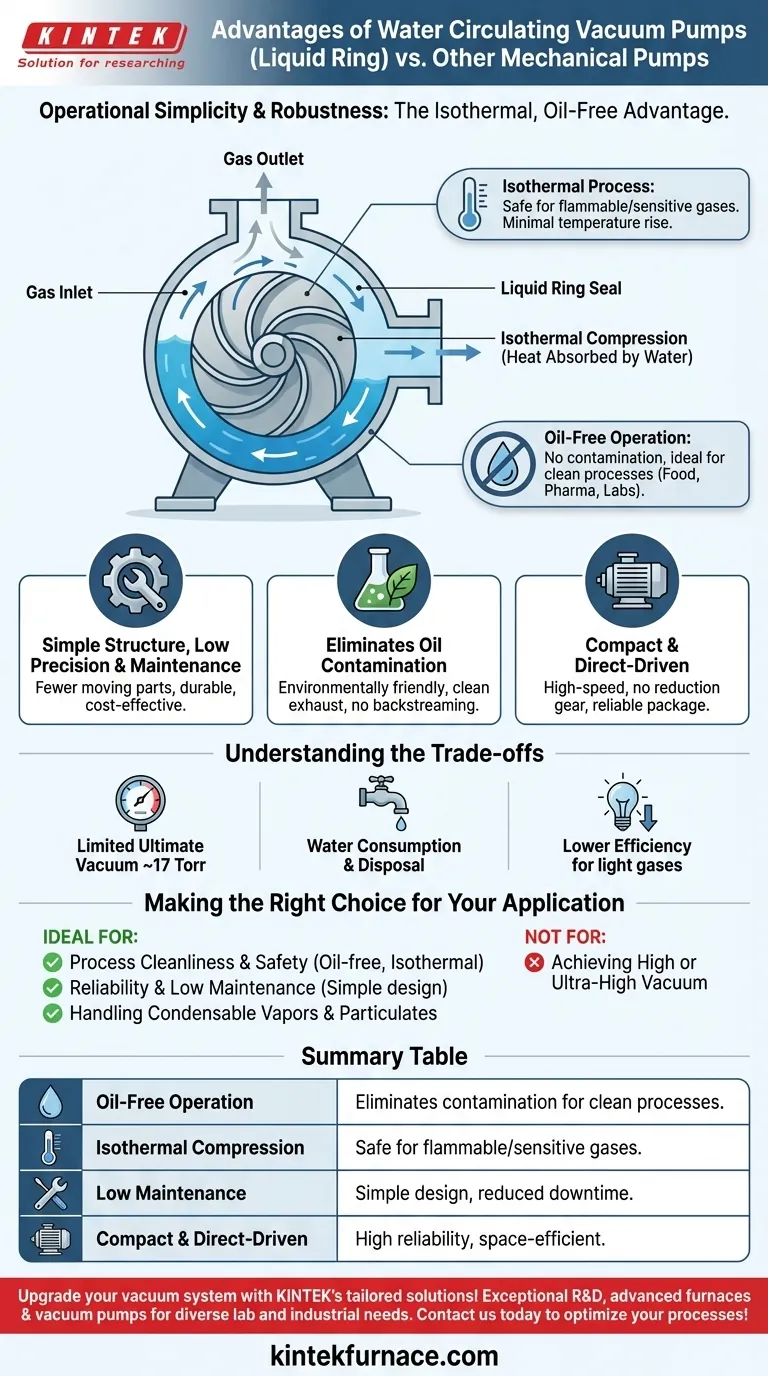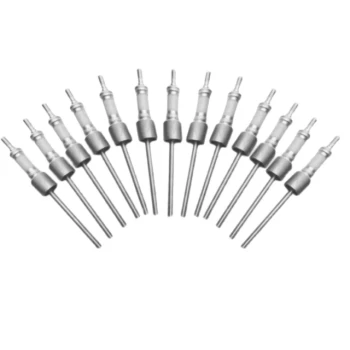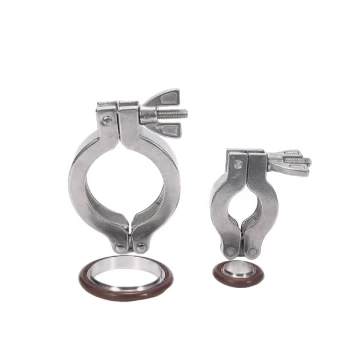At their core, water circulating vacuum pumps offer a unique combination of operational simplicity and robustness. Compared to other mechanical pumps, their main advantages stem from using a ring of water as the primary sealing and compressing medium. This design leads to an isothermal compression process, eliminates the need for oil lubrication, and results in a simple, reliable, and easy-to-maintain machine.
The true value of a water circulating pump is not just its simple design, but its inherent ability to handle difficult gas streams without oil contamination and with minimal temperature increase. This makes it a uniquely safe and clean choice for specific industrial and laboratory applications.

The Principle of Operation: Why Water is the Key
The distinct advantages of a water circulating vacuum pump, also known as a liquid ring pump, are all direct consequences of its core design: an off-center impeller spinning within a casing partially filled with water.
Simple Structure, Low Precision
The sealing action is created by the spinning ring of water, not by tight-tolerance metal parts. This means the pump can be manufactured with less precision than oil-sealed rotary vane or dry screw pumps. This fundamental simplicity makes them easier to produce, more cost-effective, and inherently durable.
The Benefit of Isothermal Compression
As gas is drawn into the pump and compressed, the heat generated is immediately absorbed by the large volume of circulating water. This results in a nearly isothermal (constant temperature) compression process. This is a critical advantage when pumping flammable, explosive, or temperature-sensitive gases that could react or decompose in hotter pumps.
Eliminating Oil Contamination
Because water is used for both sealing and lubrication, there is no oil inside the pumping mechanism. This completely eliminates the risk of oil vapor backstreaming into the vacuum system or contaminating the process gas. The exhaust is also free of oil mist, making these pumps more environmentally friendly and ideal for clean applications like food processing, pharmaceuticals, and laboratory work.
Compact and Direct-Driven Design
These pumps can operate at high rotational speeds, which allows them to be directly connected to a standard motor. This eliminates the need for a reduction gear set, a common point of failure and maintenance in other pump systems. The result is a more compact, simpler, and more reliable overall package.
Understanding the Trade-offs
While highly advantageous in certain scenarios, it's crucial to understand the limitations of water circulating pumps to make an informed decision.
Ultimate Vacuum Pressure
The deepest vacuum a water circulating pump can achieve is limited by the vapor pressure of the sealing liquid. For water at 15°C (59°F), this is around 17 Torr (23 mbar). This makes them unsuitable for high or ultra-high vacuum applications, which require pressures many orders of magnitude lower.
Water Consumption and Disposal
While the water circulates, some is inevitably lost to evaporation and must be replenished. Furthermore, if the process gases are corrosive or contaminating, the sealing water will become contaminated over time. This may require a system to cool, clean, or treat the water before discharge, adding an operational cost and complexity.
Pumping Efficiency
The efficiency can be lower compared to some dry mechanical pumps, especially when pumping light gases like hydrogen or helium. The energy is spent moving both the gas and the significant mass of the water ring.
Making the Right Choice for Your Application
Selecting the correct vacuum technology depends entirely on the specific requirements of your process.
- If your primary focus is process cleanliness and safety: The oil-free, isothermal operation makes a water circulating pump an ideal choice for handling sensitive, flammable, or soluble gases and vapors.
- If your primary focus is reliability and low maintenance: The simple, robust design with few moving parts and no oil to change offers unparalleled operational uptime in demanding industrial environments.
- If your primary focus is achieving high vacuum: This pump is not the right tool; you must consider multi-stage systems using dry screw, turbomolecular, or diffusion pumps.
- If your primary focus is handling condensable vapors or small particulates: The liquid ring can condense vapors and flush away small solids that would seize or destroy other mechanical pumps.
Ultimately, understanding these core principles empowers you to choose a pump that is not just functional, but perfectly suited to your goal.
Summary Table:
| Advantage | Description |
|---|---|
| Oil-Free Operation | Eliminates oil contamination, ideal for clean processes in food, pharma, and labs. |
| Isothermal Compression | Maintains constant temperature, safe for flammable or sensitive gases. |
| Low Maintenance | Simple design with fewer moving parts, reducing downtime and costs. |
| Compact and Direct-Driven | High-speed operation without gears, enhancing reliability and space efficiency. |
Upgrade your vacuum system with KINTEK's tailored solutions! Leveraging exceptional R&D and in-house manufacturing, we provide advanced high-temperature furnaces and vacuum pumps designed for diverse laboratories and industrial applications. Our product line includes Muffle, Tube, Rotary Furnaces, Vacuum & Atmosphere Furnaces, and CVD/PECVD Systems, complemented by deep customization to meet your unique needs. Whether you require oil-free operation, enhanced safety, or reliable performance, KINTEK delivers. Contact us today to discuss how we can optimize your processes and drive efficiency!
Visual Guide

Related Products
- Ultra Vacuum Electrode Feedthrough Connector Flange Power Lead for High Precision Applications
- 1400℃ High Temperature Laboratory Tube Furnace with Quartz and Alumina Tube
- Laboratory Vacuum Tilt Rotary Tube Furnace Rotating Tube Furnace
- Laboratory Muffle Oven Furnace with Bottom Lifting
- 1400℃ Controlled Inert Nitrogen Atmosphere Furnace
People Also Ask
- What combination of pumps is typically used for vacuum sintering furnaces? Boost Efficiency with Rotary Vane & Roots Pumps
- What is the primary function of the vacuum pump system in the magnesium powder evaporation process? Ensure High Purity & Efficiency
- How does the retort in a hot wall furnace prevent collapsing under vacuum? Key Design Insights for Durability
- What are the main technical requirements for vacuum pumps in vacuum sintering furnaces? Ensure Material Purity and Efficiency
- What are the specifications of the vacuum system in PECVD equipment? Optimize Your Thin-Film Deposition Process



















